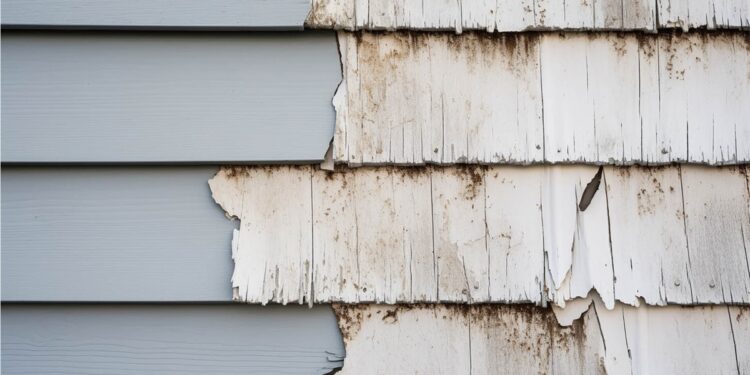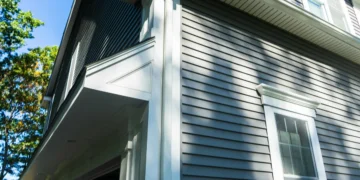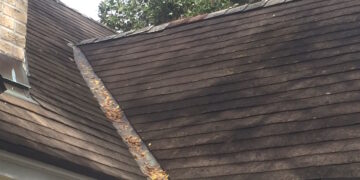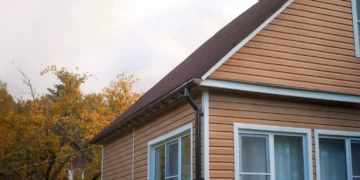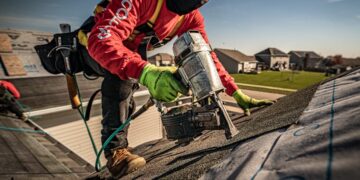Damaged siding, a common issue faced by homeowners, can stem from various causes and manifest in different ways. This guide delves deep into the world of damaged siding, shedding light on its types, inspection processes, repair methods, and more. Get ready to uncover everything you need to know about dealing with damaged siding.
Causes of Damaged Siding
Damaged siding can stem from various sources, ranging from environmental factors to improper installation practices.
Environmental Factors
- Exposure to harsh weather conditions such as extreme heat, freezing temperatures, heavy rain, and strong winds can cause siding to crack, warp, or deteriorate over time.
- Prolonged exposure to sunlight can lead to fading and discoloration of siding materials, impacting both the aesthetic appeal and structural integrity.
- Mold, mildew, and algae growth due to moisture accumulation can not only mar the appearance of siding but also compromise its durability.
Improper Installation
- Inadequate sealing or fastening during installation can result in loose or shifting siding panels, making them susceptible to damage from wind or debris impact.
- Failure to allow for proper expansion and contraction of siding materials can lead to buckling or warping, causing unsightly gaps or bulges in the siding.
- Poorly executed cuts or overlaps in siding installation can create weak points that are prone to water infiltration, accelerating deterioration and rot.
Types of Damaged Siding
When it comes to siding, there are various types of damage that can occur, each with unique visual indicators and levels of severity.
Cracks
Cracks in siding are a common type of damage that can be caused by various factors such as extreme weather conditions, age, or poor installation. These cracks can vary in size and shape, and can lead to moisture seeping into the underlying structure.
Warped or Buckled Siding
Warped or buckled siding is often caused by exposure to heat or moisture. This type of damage can be visually identified by irregular bulges or distortions in the siding panels, which can compromise the overall integrity of the siding.
Holes or Punctures
Holes or punctures in siding can occur due to impact from debris, animals, or improper installation. These damages can range from small punctures to larger holes, which can expose the interior of the walls to moisture and pests.
Fading or Discoloration
Fading or discoloration of siding is typically a sign of prolonged exposure to sunlight and weather elements. While this type of damage may not affect the structural integrity of the siding, it can significantly impact the curb appeal of the property.
Peeling or Chipping Paint
Peeling or chipping paint on siding is a common issue that can occur over time due to wear and tear. This type of damage can make the siding look worn out and neglected, requiring repainting or replacement to maintain its appearance.
Inspection and Assessment
When inspecting damaged siding, it is crucial to follow a systematic approach to accurately assess the extent of the damage. By using the right tools and techniques, you can determine the best course of action to repair or replace the siding effectively.
Step-by-Step Process for Inspecting Damaged Siding
- Start by visually inspecting the siding for any visible signs of damage such as cracks, holes, warping, or discoloration.
- Probe the damaged areas gently to check for soft spots or rot that may indicate deeper damage.
- Use a moisture meter to detect any moisture trapped behind the siding, which can lead to mold or mildew growth.
- Check for signs of insect infestation or pest damage that can weaken the siding material.
Guidelines on Assessing the Extent of Damage on Siding
- Measure the size of the damaged area to determine if a repair or replacement is necessary
.
- Assess the structural integrity of the siding to ensure it can still provide adequate protection for your home.
- Consult with a professional contractor to get a comprehensive evaluation of the damage and recommended solutions.
Tools and Techniques for Evaluating Damaged Siding
- Use a siding gauge to measure the thickness of the siding material and identify any areas that may need reinforcement.
- Perform a tap test by gently tapping the siding with a hammer to check for areas that sound hollow, indicating potential damage.
- Consider using a thermal imaging camera to detect temperature differences that could indicate insulation problems or water intrusion behind the siding.
Repair and Maintenance
When it comes to repairing damaged siding, it is important to follow best practices to ensure a seamless and durable fix. Matching new siding with existing materials during repairs can be a challenge, but with the right approach, it can blend in seamlessly.
Additionally, implementing preventive maintenance measures can help avoid siding damage in the future.
Best Practices for Repairing Damaged Siding
- Assess the extent of the damage before starting any repairs to determine the best course of action.
- Replace damaged or warped siding panels with new ones that match the color and texture of the existing siding.
- Secure loose siding panels and trim to prevent further damage or detachment.
- Seal any gaps or cracks in the siding to prevent moisture infiltration.
- Paint or finish the repaired area to ensure a uniform appearance.
Matching New Siding with Existing Materials
- Take a sample of the existing siding to a home improvement store to find a matching replacement.
- If an exact match is not available, consider painting or staining the new siding to blend in with the old.
- Consult a professional contractor for advice on color matching and installation techniques.
Preventive Maintenance Measures
- Regularly inspect your siding for signs of damage, such as cracks, warping, or discoloration.
- Clean your siding annually to remove dirt, mold, and mildew that can cause damage over time.
- Trim trees and bushes near your home to prevent branches from scratching or damaging the siding.
- Check your gutters and downspouts for clogs to prevent water from overflowing onto the siding.
- Apply a protective sealant to your siding every few years to maintain its integrity and durability.
Last Recap
In conclusion, understanding the nuances of damaged siding is crucial for maintaining the integrity and aesthetics of your home. By following the insights shared in this guide, you'll be well-equipped to tackle any siding issues that may arise in the future.
Here's to a well-protected and visually appealing home!
FAQ Insights
What are the common reasons for damaged siding?
Common reasons include weather exposure, poor installation, and age-related wear and tear.
How can I distinguish between minor and severe siding damage?
Minor damage may include small cracks or chips, while severe damage can involve large holes or extensive warping.
What tools are typically used to assess damaged siding?
Tools like moisture meters, siding gauges, and inspection cameras are commonly used for assessment.
What preventive maintenance measures can help avoid siding damage?
Regular cleaning, inspections, and timely repairs can significantly reduce the risk of siding damage.

